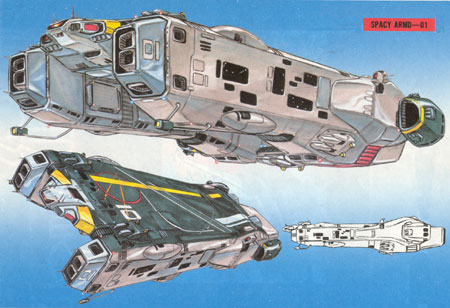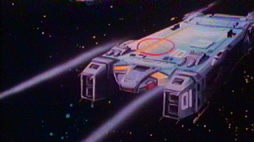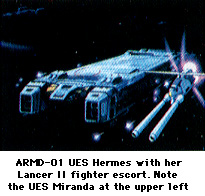

Designation:Hermes class Armored Reflex Missile Defender (ARMD), redesignated to carrier (CV) in 2013. |

|
||||

|
|||||
| ARMD-01 | Hermes | Commissioned 2008 | Destroyed 2009 in Earth orbit |
| ARMD-02 | Shokaku | Commissioned 2008 | Destroyed 2009 in Earth orbit |
| ARMD-03 | Enterprise | Commissioned 2008 | Destroyed 2009 in Earth orbit |
| CV-04 | Ark Royal | Commissioned 2009 | Decommissioned 2023 |
| ARMD-05 | Akagi | Commissioned 2009 | Destroyed in Zentraedi Holocaust |
| CV-06 | Saratoga | Commissioned 2009 | Decommissioned 2023 |
| ARMD-07 | Ranger | Commissioned 2009 | Destroyed in Zentraedi Holocaust |
| ARMD-08 | Illustrious | Commissioned 2010 | Destroyed in Zentraedi Holocaust |
| ARMD-10 | Langley | Commissioned 10/2008 | Destroyed 2009 in Earth orbit |
| CV-11 | Shinano | Never Commissioned | Destroyed 2014 with Odyssey |
| CV-12 | Lexington | Never Commissioned | Destroyed 2014 with Odyssey |
These ships were built at the L-5 Factory from 2005 through 2010.


The ARMD or Armor series carriers formed the backbone of the RDF's orbital fleet. The Armors were designed shortly after the arrival of the SDF-1 on Macross Island, at a time when many Tirolian technologies were not yet available. This factor has hampered the Armor craft throughout their lives.
Because of the newness of the technology, a fold drive could not yet be fitted as its principle was not yet sufficiently understood. However, mass and space for a fold drive was reserved in the design, to facilitate refitting. This allowance was then filled (temporarily) with a long duration low thrust drive system (ion drive), which gave the Armor class a rudimentary inter-planetary capability, which was never utilized. Unfortunately, power demands for the combat systems turned out to be far higher than anticipated, and in fact in excess of the Armor's generating capacity. It was not until 2009 that the necessary refits were finally designed and prepared. At the time of the Zentraedi arrival however, four Armors were destroyed by the Zentraedi without much trouble, and hence the effectiveness of the design was called into question. Therefore, the refits were put on hold, and the building program suspended. The nine Armors completed up to then would remain nine forever.
An interesting design feature was the capability of the Armor class to dock the engine section to the 'shoulder-locks' of the SDF-1. This was done so as to increase the combat power and versatility of the SDF-1 while also extending the Armor's capabilities. However, the two Armors to attempt this link-up were destroyed prior to rendezvous by Zentraedi fire.
The Armor series was a completely Terran design, made without any knowledge other than the basic principles of space-warfare tactics. The shape of the Armors therefore borrows little of any Tirolian or Zentraedi design, in contrast to later Terran ships. The Armor was made up of five main sections. The main control section of the Armors was located in the small bridge section forward on the centerline. Aft of this was the flight deck, with hangars, elevating arms that placed mecha outside the ship for take-off and recovered them when landing, and to the rear the reaction mass tanks. Two large sponsons flanked the flight deck and extended downward from it, forming a large well between them. Inside the sponsons were the magazines for the large SLBM missiles, the quick-release bays for the space fighters and the conveyors to the main flight deck hangars, and, forward of this, the maneuvering thruster clusters. Aft of the flight deck and the upper part of the sponsons was the engine section, with one large central exhaust flanked by the ion and secondary engines. It was intended that a fold-drive would be installed as soon as the Robotech Research Groups had developed and built them to satisfactory standards. The additional engine would then have made up a sixth section, and be located in the well between the sponsons. The ion drive units would also have been deleted during this refit.
The armament was a mixture of traditional Terran and Tirolian technologies. Five large particle beams of the extremely advanced design found on the SDF-1 were mounted. These designs were several generations more advanced than those mounted on Zentraedi Battlecruisers. However, the rate of fire proved to be extremely disappointing. The two SLBM launchers fired their weapons through two hatches in the upper rear of the sponsons. The weapons were expelled horizontally from the ship and then ignited. The rate of fire was quite impressive for such a heavy installation, at three missiles per second per launcher. Also, six triple-barreled laser turrets with more or less the equivalent firepower of the standard Zentraedi laser-turret design were located around each auxiliary engine, and six missile launchers were placed around the vessel for area defense. As a last-ditch defense, 24 laser cannons were located in pop-up turrets on both the ventral and dorsal sides of the ship. Unfortunately, the powerplant installed on the ARMD cruisers was woefully insufficient, and the guns' rates of fire, especially that of the largest weapons, suffered for it.
The strategies for which this weapon fit was conceived were based on the expectations that RDF planners had of the Zentraedi attack capabilities and tactics. These however were based on the examination of the SDF-1, which was assumed to be a typical example of a large Zentraedi warcraft. As such, it had one main cannon, a number of smaller batteries, and hangar capacity for about 1500 mecha. The planners could not imagine anyone building a very much larger vessel, and therefore the SDF-2, under construction on the moon, was to be a copy of the SDF-1, and hoped to be superior to most other ships. As such, smaller escort ships were expected, and possibly versions of the Battlefortress, without the main gun but with a large troop-carrying capacity for use in planetary landings. Also, given the power of the ship, it was not expected that alien Battle Groups would comprise more than one SDF-1 class vessel per group. These assumptions, while logical and sensible, were utterly wrong. In defense of the analysts it must be stated that the SDF-1 was definitely not a typical example of a Zentraedi ship-of-the-line, but a new type of Border Fleet battleship intended for extended missions. Most Zentraedi ships were far larger than the SDF-1, carried far more mecha and operated in fleets ranging from 12 to 10,000 individual ships. The Adoclas Fleet, which Breetai folded to Earth-space to relieve Azonia of command, numbered one million+ ships.
It was intended that the Armor class ships, escorted by Oberth-class system destroyers, would take out the single large ship in an alien battle group. This was to be accomplished by firing the large particle beams at long range, disabling the enemies' main cannon in the process. Then the Armors were to close with the vessel, still firing the particle beams, and finish the ship off with concentrated SLBM barrages. The drones and mecha were launched with the SLBMs to take out any alien mecha that had managed to escape the destruction of their ships. Unfortunately, the Zentraedi vessels were larger and tougher than expected, carried enough mecha to overwhelm the defenses of the Armors, had more firepower than they could handle, and outnumbered them enormously to boot.
As the first few vessels neared completion, it was decided to introduce an alternative design. The first series was known as the Armor-0 type, the new design would be the Armor-1 type. This showed in the hull numbers, which were either -0x or -1x, dependent on the design type. While the original plan (series -0) had not included anything but a token complement of VF-1 Valkyries, ARMD-10 (first of the series -1) was designed with Valkyries in mind. Though there were no obvious external differences, the internal arrangement of the vehicle, especially in the hangar areas, was quite different. The ARMD-10 entered service at the same time as ARMD-3. Two partial ARMD carriers were built as part of the SDF-2 project; these ships, ARMD-11 and ARMD-12, had no engine section at all, and were mainly to serve as external carriers on the SDF-2 Odyssey. These vessels are not included in most records of the class history.
Because of the obvious inefficiency of the Hunter and Lancer fighters, the two Armor cruisers that survived the Holocaust were refitted around the Valkyries, in the manner of ARMD-10.
Nine Armor-class vessels were constructed in the L5 point by the RDF from 2005-2010. Four of these were finished by the time of the Zentraedi arrival, and were all destroyed during the initial assault. Though all vessels were given names, these never took, and the ships were invariably referred to as "Armor" followed by their call-number. Armor 2 was destroyed in the first battle after the Zentraedi fleet arrived in Earth orbit, while Armors 1, 3, and 10 were destroyed during an attempt to link up with the SDF-1. There were 12 other Armors under construction in the L5 factory, but there were only sufficient powerplants available for five of them. This, coupled with the ease with which the first Armors were destroyed, led to the cancellation of the last seven. The other five were completed just in time for three of them to be destroyed in the Zentraedi Holocaust. These were Armor 5, 7, and 8. Armor 4 and 6 were at that time orbiting the moon, filled with officers the UEG brass had decided were not like-minded politically, with orders to support the SDF-1 in its ordered suicide attack on Breetai's fleet after the firing of the Alaskan main cannon at it. It was intended that these Armors would be destroyed with the SDF-1 and its political time-bomb load of refugees, after which the Zentraedi would hopefully go and leave the Earth in peace, and the UEG securely in charge. Fortunately, Breetai's peace initiative prevented its execution. This plan later caused the court-martial of several survivors known to have supported it. Armor 4 and 6 survived the Holocaust, as they were unable to participate in the battle itself due to their low speed. After the war they served as orbital bases until they were decommissioned in 2023 with the other orbital fleet units. ARMD-11 and ARMD-12 were constructed as part of the SDF-2 project, and were ARMD carriers in name only. Though they shared identical frames with the ARMD-10, they had no engines and were permanently mated to the Odyssey's arms. As such, they are generally not considered separate vessels, but rather part of the Odyssey. They were lost with the SDF-2 Odyssey in January 2014.
Return to RDF Naval index
Go to Robotech Reference Guide Home Page
Robotech (R) is the property of Harmony Gold. This document is in no way intended to infringe upon their rights.
Content by Pieter Thomassen with Peter Walker